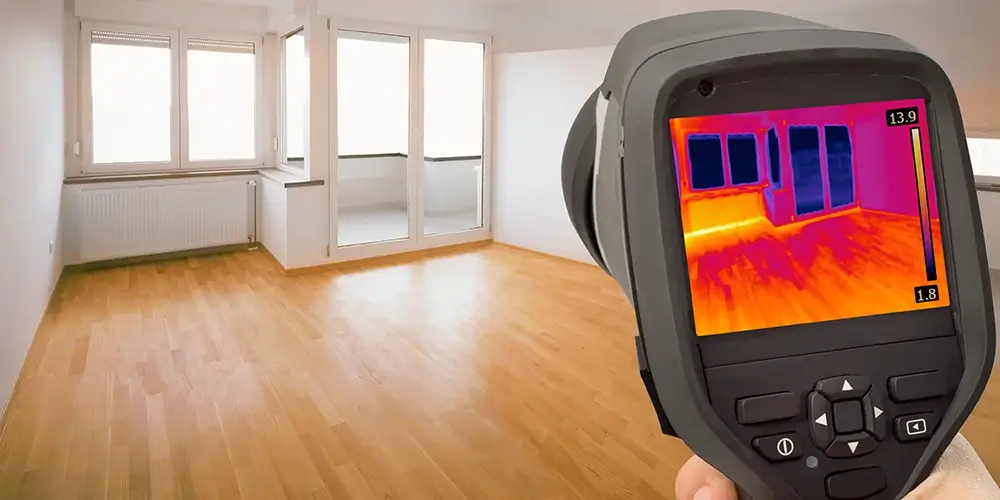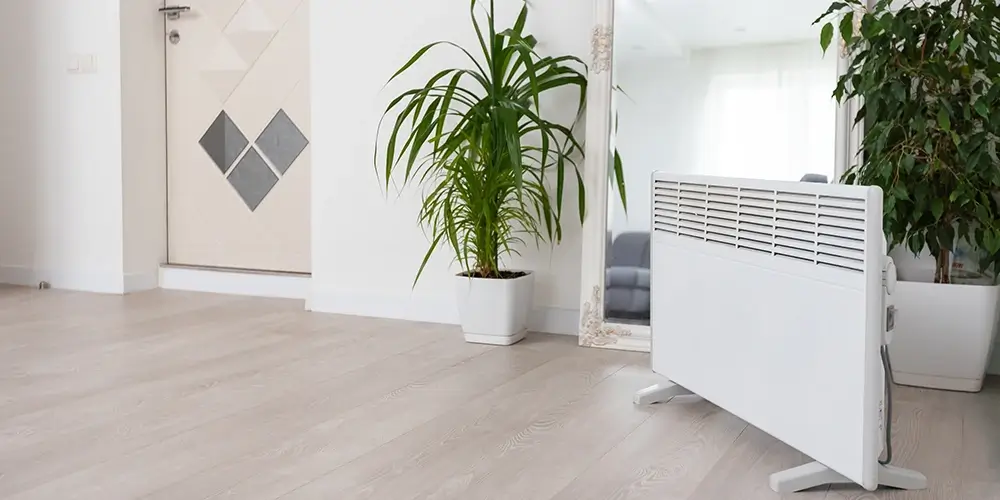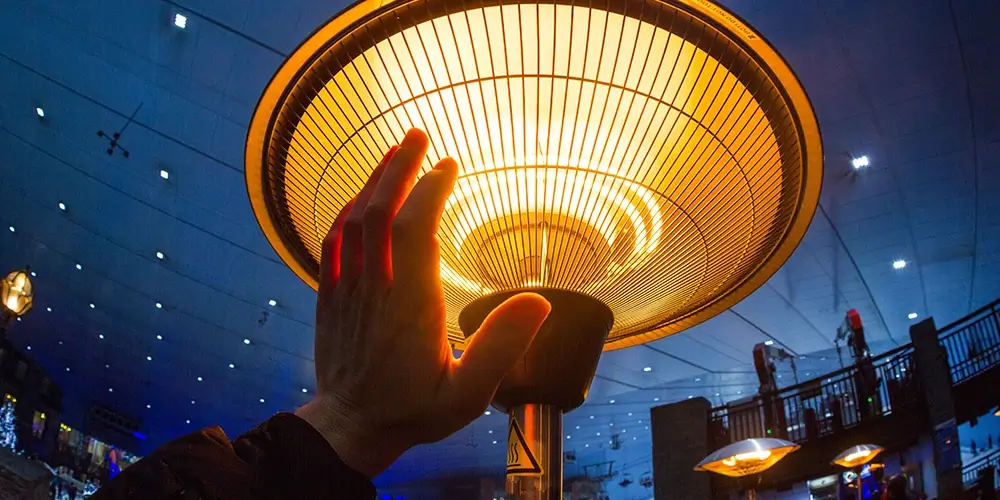Radiant Heating Repair & Installation

What Is Radiant Heating?
Radiant heating works by infrared heat transfer — “The delivery of heat directly from a hot surface to the people and objects in a room via infrared radiation” (Energy.gov).
Some simple forms of radiant heat include:
- The heated coils of an electric stove
- The sun’s infrared rays
- A campfire’s heat
Building a campfire is one way to enjoy radiant heat. But it’s not the best option for your living room compared to:
- Under-the-floor radiant heating systems (hydronic or electric)
- Infrared wall panels
- Infrared ceiling panels
- Radiant spot heaters
West Coast Chief services all types of radiant heating systems in greater Los Angeles and Orange County.
Benefits of Radiant Heating
- Lower energy bills: Radiant heating is 20% to 50% more efficient than forced-air systems. There’s no heat loss through ductwork or rising air.
- Increased comfort: Infrared waves heat objects and people directly rather than heating air, as forced-air systems do. There are no drafts, and the temperature is evenly distributed throughout the space.
- Reduced allergens and pollutants: Radiant heating doesn’t circulate dust and other allergens, unlike the blower in your forced-air furnace, and it doesn’t dehumidify the air.
- Longer lifespan: Radiant heating systems often last 20 years or more with minimal maintenance.
- Noiseless operation: Radiant heating panels don’t produce a forced-air system’s humming and rushing sounds.
- Aesthetics: Panels can be hidden under the floor, on a wall, or on the ceiling. They don’t intrude, and they don’t occupy living space. Some wall-mounted panels hang like a painting.
- Heat where it’s needed: Radiant heating panels let you independently adjust the temperature of any room.
- Rapid heating: Radiant panels have the quickest response time of any heating system.
- Safety: Radiant technology is so safe it can be installed in dog houses and chicken coops!
Conventional heaters distribute heat through forced air circulation. Warm air rises and loses heat as it hits the ceiling, then falls to the floor as it cools.
This makes the upper layer of the air hotter compared to the lower areas of the room, wasting up to 30% of heat in the process.
Radiant heaters use the direct warmth of infrared radiation. When the heater turns off, the room feels warm for a while because the infrared radiation warms people, objects, and furniture, not air.

Types of Radiant Heating
Radiant heating comes in two configurations: hydronic (liquid-based) and electric.
Hydronic Radiant Heating
Hydronic radiant heating is uncommon in Southern California homes, although it’s gaining popularity in commercial construction.
A hydronic system circulates heated fluid to warm a room.
- A boiler or heating element heats the liquid (water or glycol, another name for antifreeze).
- A pump pushes the heated liquid through pipes embedded in the floor or installed behind the walls or ceiling.
- These pipes are arrayed in “radiant panels.”
- The radiant panels convert the heat into infrared energy, at which point they “radiate.”
- A thermostat controls the boiler or heating element, maintaining the desired room temperature.
Hydronic heating can be installed under any flooring, including wood, tile, laminate, and carpet. It can supplement an existing forced-air heating system; the two systems can even share the same thermostat.
The same hydronic system can cool a room during the summer if you run the fluid through a refrigeration component.
When to Install under-the-Floor & in-the-Wall Hydronics
The best time to install is during new construction or a major renovation. It makes less sense to install hydronic heating in a building with finished floors and walls because the system needs access to the floor joists or wall studs. Pipes are installed under floors or inside walls and ceilings.
West Coast Chief won’t install the piping (a plumbing job), but we service, replace, and install heating elements, boilers, and electronics: the parts of the system most likely to cause trouble.
Electric Radiant Heating
Electric radiant heating uses electrical resistance — like the coils in an electric stovetop — to emit infrared waves.
The system is installed much like hydronic heating, minus the pipes. Radiant floor mats and heat film can simplify the process.
Thermostats or apps control the system and maintain the desired room temperature.
Electric radiant heating is more expensive than hydronic, but it’s easier to install because it doesn’t require plumbing.

Infrared Panels: An Easier & Cheaper Way to Go
Many homeowners opt for infrared panels that attach to a wall or ceiling. All you need are mounting brackets and an electrical outlet!
- They’re completely out of the way.
- They’re very safe.
- They don’t require extensive remodeling.
- Some panels look like artwork!
Hydronic Infrared Panels
These aluminum wall panels contain tubing connected to a manifold and the home’s water heater. Framed hydronic infrared panels can be mounted on a wall; these contain all the components of a full-size room system in miniature. Just hang them and plug them in!
But electric panels offer the ultimate flexibility.
Electric Infrared Panels
Electric panels use resistance wires instead of fluid to radiate heat. They’re more expensive than hydronic panels but can be mounted almost anywhere, including the ceiling. All you need is an electrical outlet (and wall space for the panel).
Electric infrared panels are ideal for:
- Bathrooms
- Offices
- Garages
- Workshops
- Colder areas of the home
They’re warm to the touch but not hot, far safer than space heaters, and designed to enhance your living space. Some look like artwork and are half an inch thick!
They radiate gentle, natural, and evenly distributed warmth, so you’ll never have to worry about cold spots or drafts again.
Hardwired Infrared Panels vs. Plug-in
Plug-in electric panels are easy as pie to install. Hanging one or of them would be a DIY project for most people.
But if you’re installing panels throughout the house, you’ll want to hardwire them to your electrical network and control them from a single thermostat or app.
Hardwiring anything electrical is a job for professionals.

Tubular Radiant Heating
Tubular radiant heaters look like long fluorescent light bulbs. They’re often installed in commercial and industrial settings, like warehouses, and are available in various lengths and wattages.
They can be hardwired or plugged into an outlet. Hardwired heaters require professional installation.
Tubular radiant heaters are highly efficient and can last up to 20,000 hours.
Radiant Floor Mats
Radiant floor mats are an excellent option for do-it-yourselfers. Roll out the mat, connect it to the power supply, and you’re done!
They can be placed under most types of flooring, including:
- Carpet
- Tile
- Linoleum
- Wood
Some mats can be used outdoors, on patios and decks.
Inferno Radiant Heaters
Inferno radiant heaters are a new type that provides instant, concentrated heat. They’re suitable for indoor or outdoor use and can be mounted on a wall or ceiling or placed on the floor.
They’re safe for children and pets because they don’t get hot to the touch. Best of all, they’re 100% energy-efficient!
Inferno radiant heaters are ideal for:
- Garages
- Warehouses
- Workshops
- And more!
Radiant Heat Installation & Repairs
Radiant heat units are durable but not indestructible. Heating cables and mats can break, and tubing can develop leaks. Hydronic systems need periodic flushing and bleeding. Air and dirt can enter the system and reduce its efficiency.
Major fixes and installations should be left to professionals. Incorrectly installed tubes and wires can endanger your household and violate state and local codes.
West Coast Chief’s certified technicians know the codes, safety requirements, and best practices to get the most out of your radiant heating system.
Call us today!